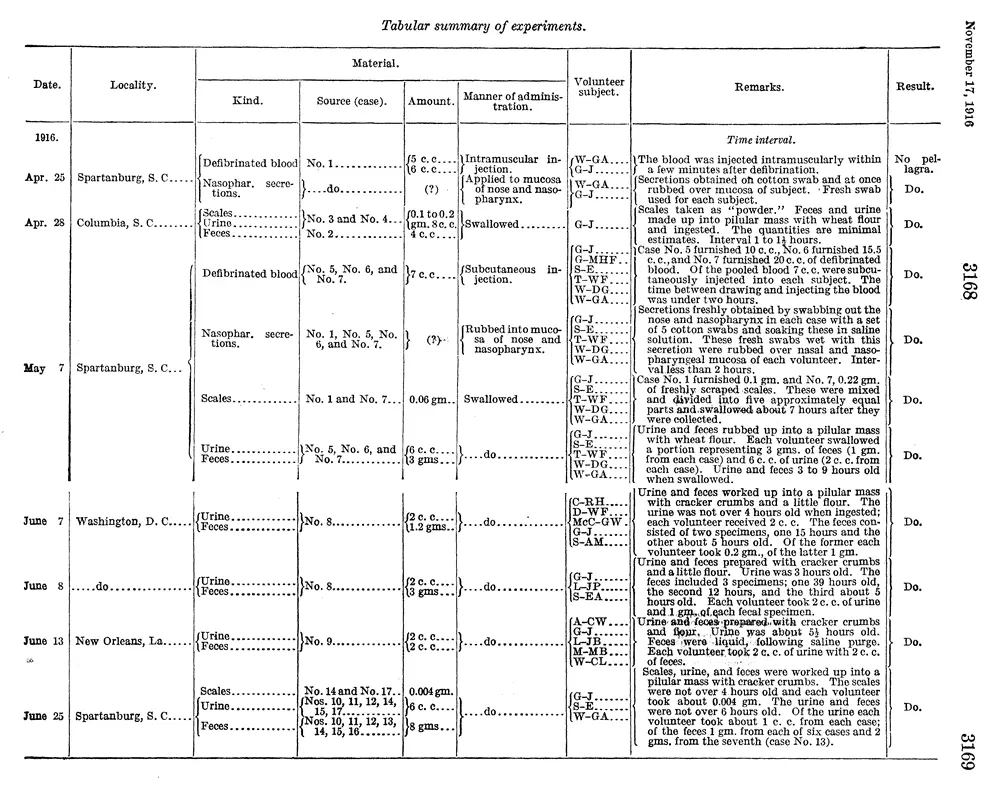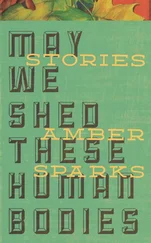(a) Scales. —Epidermal scales were scraped from pellagrous skin lesions of two patients (cases No. 14 and No. 17) at the United States Pellagra Hospital. They were not over four hours old when ingested.
(b) Urine. —TJrine was obtained from three patients (cases No. 10, No. 11, and No. 12) at the county farm and from three (cases No. 14, No. 15, and No. 17) at the Pellagra Hospital.
(c) Feces. —Feces were obtained from four patients (cases No. 10, No. 11, No. 12, and No. 13) at the county farm and from three (cases No. 14, No. 15, and No. 16) at the Pellagra Hospital. Two of the fecal specimens were from patients (cases Nos. 12 and 13) with diarrhea.
The seven patients who furnished the material for this experiment were suffering from attacks of varying grades of severity (see list of pellagra cases), including two fatal cases (No. 12 and No. 13).
Measured quantities of the materials mentioned were worked up with cracker crumbs and a little flour into a pilular mass. Fifteen minutes after taking a dose of 20 grains of sodium bicarbonate this was ingested by each of the three volunteers, G-J, S-E, and W-GA, each taking the equivalent of about 4 milligrams of scales, 6 c. c. of urine (1 c. c. from each patient), and 8 grams of feces (2 grams from case No. 13 and 1 gram from each of the other six patients). The feces and urine were not over six hours old when ingested.
Effects. —Volunteer G-J, who participated in all of the preceding experiments and who as was noted had an attack of indigestion and diarrhea for about one week following the first ingestion experiment, experienced some mild dyspeptic symptoms for a number of days immediately after this.
Within two or three hours after the experiment volunteer S-E began to feel nauseated. The following morning he had three watery evacuations and 12 hours later a diarrhea began that lasted about a week. Nausea persisted for about the same period.
Volunteer W-GA had some slight ill-defined dyspeptic symptoms for about 24 hours following the experiment.
Aside from these immediate, temporary disturbances none of the volunteers has experienced any appreciable effects.
The first experiment was made on April 25 and the last on June 25, so that the volunteers have now (Nov. 16, 1916) been under observation for from four and one-half to six and one-half months, approximately. Observation has been maintained by association with a majority of the volunteers, by visits of inspection to the others, supplemented by reports from the volunteers themselves, or in the case of the laymen from medical officers with whom they are associated.
In four or five instances, as above noted, there were more or less marked immediate, but temporary, gastrointestinal reactions following, and, probably, due to the ingestion of the large doses of excreta. When one considers the relatively enormous quantities of filth taken the reactions experienced were surprisingly slight.
One of the volunteers, S-E'A, had an attack of renal colic of eight to nine days' duration, from August 14 to August 22, 1916. Aside from this he, as well as the other volunteers, has enjoyed his usual health. None has developed any evidence justifying even a suspicion of pellagra.
It is not my present purpose to enter into a discussion of the etiology of pellagra. I may be permitted, however, to recall by way of contrast the result of the feeding experiment carried out last year (Goldberger and Wheeler, 1915). In that experiment, of 11 convicts subsisting on a one-sided diet, not less than 6 developed definite evidence of pellagra, while of over 30 controls not one showed any evidence that would justify even a suspicion of the disease.
It would appear, then, that while the opinion that pellagra is a communicable disease gains no support from the work here reported, the conclusion, elsewhere drawn (Goldberger, 1916), that it is a disease essentially of dietary origin, brought about by a faulty, probably " deficient," diet is materially strengthened.
Sixteen volunteers were subjected to experiment. With one exception all were men and varied in age from 26 to 42 years. No restraints were imposed on their customary habits or activities.
Seventeen cases of pellagra of various types and of different grades of severity furnished some one or more of the experimental materials.
The materials were blood, nasopharyngeal secretions, epidermal scales from pellagrous lesions, urine, and feces. Blood was furnished by 4 of the cases, nasopharyngeal secretions by 4, epidermal scales by 5, and urine or feces by 16, of whom 10 furnished both urine and feces, 3 urine without feces, and 3 feces without urine.
Blood was administered by intramuscular or subcutaneous injection; secretions by application to the mucosa of the nose and nasopharynx ; scales and excreta by mouth.
Both urine and feces were ingested by 15 of the volunteers, 5 of whom also took blood, secretions, and scales.
The experiments were performed at four widely separated localities (Washington, D. C.; Columbia, S. C.; Spartanburg, S. C.; and New Orleans, La.), at which different groups of the volunteers were assembled.
Observation has been maintained by association with a majority of the volunteers and by visits of inspection, supplemented by reports from the volunteers themselves, 13 of whom are physicians, and by reports from other medical officers of the service with whom they are associated. During a period of between five and seven months none has developed evidence justifying a diagnosis of pellagra.

These experiments furnish no support for the view that pellagra is a communicable disease; they materially strengthen the conclusion that it is a disease essentially of dietary origin, brought about by a faulty, probably " deficient," diet.
My sincere thanks are due Dr. C. F. Williams, superintendent, Dr. W. C. Sandy, medical director, and Drs. D. ,W. Eegister and J. F. Munnerlyn, assistant physicians, of the South Carolina State Hospital for the Insane, for access to and for material from cases of pellagra. My thanks are due also to Drs. W; M. Barton and Eeiss for material from a case at the Washington Asylum Hospital, Washington, D. C.; to Drs. I. I. Lemmon and C. Dean for material from a case at the Charity Hospital, New Orleans; to Dr. O. W. Leonard, .of Spartanburg, S. C, for material from cases at the Spartanburg County Farm; and to Dr. B. M. Grimm for material and for assistance in carrying out some of the experiments at the United States Pellagra Hospital.
I have, finally, to make grateful acknowledgment of my indebtedness to those of my colleagues and associates of the service whose willing participation in a trying ordeal made this work possible.
Volunteers.
A-CV.—Medical officer, 26 years. Stationed at New Orleans, La. Participated in experiment No. 6.
C-RH.—Medical officer, 37 years. Stationed at Washington, D. C. Participated in experiment No. 4.
D-WF.—Medical officer, 32 years. Stationed at Washington, D. 0. Participated in experiment No. 4.
G. J.—Medical officer, 42 years. Stationed at Washington, D. C. Major part of the time spent in field work in Southern States. Participated in all seven experiments.
G-MHF.—Housewife, 35 years. Resides at Washington, D. C. The only woman among the volunteers. Participated in experiment No. 3 at Spartanburg, S. C.
L-JB.—Medical officer, 28 years. Stationed at New Orleans. Participated in experiment No. 6.
L-JP.—Medical officer, 35 years. Stationed at Washington, D. C. Participated in experiment No. 5.
Читать дальше












